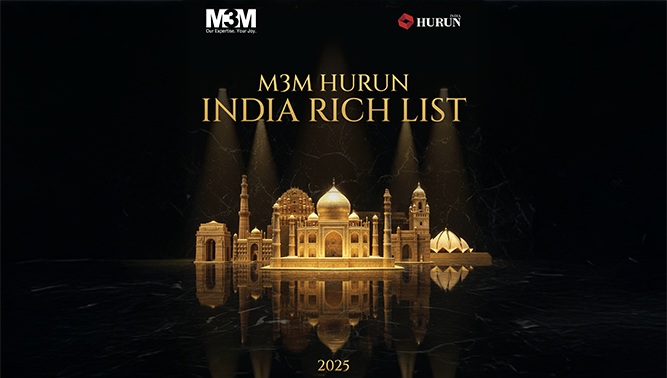The M3M Hurun India Rich List 2025 captures how jewellers continue to illuminate the nation’s economy and imagination

From the gold markets of Thrissur to the diamond lanes of Surat and the boutiques of Mumbai, India’s jewellery magnates have firmly cemented their place among the country’s ultra-wealthy, as evidenced by the M3M Hurun India Rich List 2025.
Of the more than 1,300 individuals on the list, over 40 are from the jewellery and gems trade, together representing a glittering testament to India’s deep, enduring relationship with adornment — and enterprise.
The Gold Standard of Wealth
At the top of the pack sits Joy Alukkas, ranked 24th with an estimated wealth of Rs.88,430 crore. The Thrissur-based entrepreneur’s eponymous brand — with over 160 stores worldwide — has grown from a regional chain into one of the world’s largest jewellery retailers. “Gold has always been a part of our culture, but today it’s also an investment and an emotion,” Alukkas once told Indian Jeweller. His empire exemplifies the blend of heritage and modern retail that now defines India’s jewellery sector.
Close behind is T.S. Kalyanaraman and family of Kalyan Jewellers, ranked 90th with Rs.32,670 crore. Known for transforming wedding jewellery retail into an aspirational lifestyle category, Kalyan’s reach spans over 170 showrooms across India and the Middle East. The brand’s campaigns — powered by household names from Amitabh Bachchan to Katrina Kaif — reflect how storytelling and sentiment have become as critical to jewellery sales as carats and cuts.
Southern Sparkle
If the 2025 list proves anything, it’s that South India remains the beating heart of the country’s jewellery trade. Thrissur alone, often dubbed the “gold capital of India”, is home to three billionaires on the list — Joy Alukkas, Kalyanaraman, and Allukka Jose Varghese (Rs.10,920 crore, Alukkas Enterprises).
Chennai follows close behind with the GRT Jewellers duo, Govindarajulu Radhakrishnan and Ananthapadmanabhan Govindarajulu Rajendran, both ranked 229 with Rs.13,650 crore, and Kiran Kumar of Lalithaa Jewellery (Rs.13,030 crore). These legacy brands have thrived by blending tradition with transparency, leveraging purity assurances, BIS hallmarking, and digital expansion to appeal to a new generation of consumers who value authenticity as much as aesthetics.
Diamonds and Disruption
While South India dominates gold, the diamond czars of Surat and Mumbai continue to sparkle in global markets. From Govindbhai Laljibhai Dholakia of Shree Ramkrishna Exports (Rs.5,980 crore) to Savji Dholakia of Hari Krishna Exports (Rs.3,030 crore), Gujarat’s diamantaires remain at the core of India’s export economy. Surat alone contributes nearly 90% of the world’s cut and polished diamonds, and the new Diamond Bourse — the world’s largest — only reinforces that dominance.
Mumbai, meanwhile, remains the nerve centre of trade, finance and craftsmanship, hosting stalwarts such as Ashish Goenka of Suashish Diamonds (Rs.6,560 crore), Russell Mehta of Rosy Blue India (Rs.3,110 crore), and Praful Pannalal Ranavat of Swarn Shilp Chains & Jewellers (Rs.11,380 crore). Together, they bridge traditional artistry with international scale, proving that Indian jewellers are no longer mere craftsmen — they’re global brand-builders.
Family Fortunes and Second-Generation Visionaries
A striking feature of this year’s rankings is the generational handover that’s reshaping the industry. Saurabh Vidyadhar Gadgil of P.N. Gadgil Jewellers in Pune (Rs.7,870 crore) represents the modern heir — digitally savvy, customer-first, and innovation-driven. Similarly, Suvankar Sen of Senco Gold (Rs.4,450 crore) and Mithun Sacheti of Caratlane Jewellery (Rs.2,500 crore) exemplify how second-generation entrepreneurs are marrying technology and tradition.
Their rise underscores a broader shift: jewellery is no longer a business passed down; it’s one being reinvented. From omnichannel retail to lab-grown diamonds and AI-assisted design, these heirs are steering century-old houses toward contemporary relevance.
Luxury with a Local Soul
Beyond wealth, the 2025 list highlights a philosophical shift in how Indian jewellers view their role. Whether it’s Emerald Jewels’ K. Srinivasan (Rs.4,370 crore) in Coimbatore or Balusamy Ramesh of Thangamayil Jewellery (Rs.2,850 crore) in Madurai, many of these entrepreneurs are reinvesting in local communities, skill development, and sustainable sourcing.
In an age where transparency and ethics drive consumer choices, such efforts matter more than ever. Increasingly, luxury buyers — especially millennials and Gen Z — are seeking meaning behind the metal. The jewellers who thrive are those who can fuse craftsmanship with conscience.
Regional Dominance: A Map of Prosperity
A glance at the Hurun list reveals a geographical tapestry of wealth — and ambition:
Thrissur and Chennai: The stronghold of traditional gold retailers who’ve built loyalty over decades.
Mumbai and Surat: The global diamond and export capitals, home to the most diversified portfolios.
Pune, Coimbatore, and Jaipur: The emerging centres of design, innovation, and artisanal revival.
Together, these regions tell a story of how India’s jewellery wealth mirrors its diversity — from family-run gold showrooms in temple towns to multi-national gem conglomerates.
The Business of Beauty
Jewellery remains more than adornment; it’s a cultural currency. In India, it marks milestones — births, weddings, success, legacy. That sentiment, married with entrepreneurship, explains why this centuries-old trade continues to outshine newer industries.
Despite headwinds like fluctuating gold prices, import restrictions, and digital competition, jewellers are adapting fast. Brands like Malabar Gold, Kalyan, and Tanishq are investing heavily in brand storytelling, sustainability, and international expansion. The result? Indian jewellery is no longer an export of gems alone — it’s an export of identity.
The Future Is Handcrafted
If 2025 is any indication, the next decade will see Indian jewellers evolve from merchants of gold to architects of aspiration. The challenge ahead lies not in sparkle, but in substance: sustainability, innovation, and inclusivity.
From the gleam of Thrissur’s gold markets to Surat’s diamond dust, these are not just tales of wealth — they’re stories of heritage, resilience and reinvention. And as the world continues to discover the artistry and audacity of Indian jewellery, one truth remains constant: when it comes to building empires of beauty, no one does it quite like India.
Be the first to comment